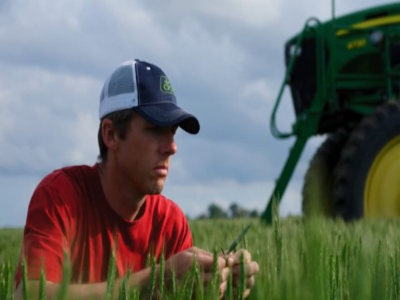By Shelbi Knisley
Across the United States, farmers are producing more and better wheat using fewer natural resources including land. According to an American Farm Bureau Federation report, in 2018 about 8 million fewer acres (3.24 million hectares) were needed to produce the same amount of wheat as in 1990.
With the Biden Administration establishing clear policy goals to fight climate change and reward conservation, it is more important than ever to share the successful stories of how U.S. wheat farmers have employed sustainable practices for many years to protect their land and make a positive impact on the environment.
U.S. farmers are more economical and sustainable today by implementing agronomic practices and investing in technologies, research, and development. Technology plays an important role in making U.S. agriculture sustainable. When breeding techniques and advanced technologies are used to produce high-yielding, high-quality wheat varieties, it contributes to preserving the land’s natural resources through water and soil nutrient conservation that work in harmony with local conditions.
In their production, U.S. wheat farmers apply many aspects of the following sustainable tools and practices:
Reduced Tillage. The USDA Economic Research Service reports that reduced tillage has grown in popularity and is now practiced on nearly 70% of U.S. wheat acres. While at times a necessary tool, traditional plowing and other deep tillage can be concerning. Continuous wheat production with deep tillage contributed to the infamous U.S. “Dust Bowl” of the 1930s. The introduction of reduced-till and no-till practices have helped reduce soil erosion and increase water retention on dryland crops. This practice also reduces fuel use and promotes carbon sequestration. Read more about the sustainability of practicing no-till farming here.
Crop Rotation and Cover Crops. After a harvest, most wheat farmers switch to a different crop in the same fields, a practice known as crop rotation. More and more farms are planting “cover crops” after harvest that will be incorporated into soil before the next crop is planted. Both these practices are beneficial in preserving soil health as well as conserving water. Cover crops add soil nutrients and organic matter and help prevent soil and water runoff. In one study, for example, Desert Durum® wheat farmers who rotate to lettuce crops following their durum harvest, have reduced water use on average about 30%.

On his family’s Kansas farm, Justin Knopf has invested in soil health through cover crops, no-till and crop rotations.
Water Conservation. Wheat is a naturally water efficient crop. In much of the United States, wheat is grown during cooler months and has a longer growing season – providing more opportunity for it to capture naturally occurring precipitation. Only about 10% of wheat acres in the U.S. are irrigated. Even when wheat is irrigated, it often needs less irrigated water than many other crops.